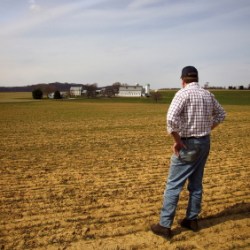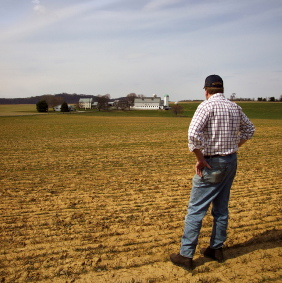
Most Americans are smart enough to think we should give this guy some tips.
Even as extreme drought wreaks havoc on crops and communities across the Midwest, government officials are now confident that they can link recent bouts of extreme weather to man-made climate change. The National Oceanic and Atmospheric Administration underscored that point in early July when it released research conducted by 378 scientists from 48 countries that “provides a detailed update on global climate indicators, notable weather events and other data collected by environmental monitoring stations and instruments on land, sea, ice and sky.”
Deputy NOAA Administrator Kathryn D. Sullivan Ph.D. summed it up this way:
Every weather event that happens now takes place in the context of a changing global environment.
Just a day after NOAA released its findings, in coordination with the American Meteorological Society, Reuters’ Chuck Abbott reported on the Department of Agriculture’s dire forecast for this year’s corn crop:
The worst Midwest drought in a quarter century is doing more damage to U.S. crops than previously expected, with the government on Wednesday slashing its estimate for what was supposed to be a record harvest.
Climate change affects agriculture more directly and profoundly than most other economic sectors. The Washington Post’s Brad Plumer has pointed out that while it’s hard to pinpoint climate change by itself as the cause of any particular drought, it’s certainly a big factor in how severe it gets. Meanwhile the danger from climate change-fueled droughts will only increase as America dithers about and polluting special interests continually block solutions.
The Dangerously Counterproductive Industrial Agriculture Lobby
It’s a sad irony to recall that three short years ago, the industrial agriculture lobby and its patrons in Congress helped scuttle the nation’s first attempt at serious climate legislation — the cap-and-trade proposal titled the American Clean Energy and Security Act of 2009.
The American Farm Bureau Federation, the largest agriculture lobby, vehemently opposed the bill. It went so far to as to embark on a public relations campaign called “Don’t Cap My Future.” Federation President Bob Stallman said then:
At the very time we need to increase our food production, climate change legislation threatens to slash our ability to do so. The world will continue to depend on food from the United States. To throttle back our ability to produce food — at a time when the United Nations projects billions of more mouths to feed — is a moral failure.
The corn lobby fell right in line with the Farm Bureau in opposing meaningful climate legislation. Mark Lambert, a spokesman for the National Corn Growers Association, wrote:
They ought to call it the economic change bill. Greenhouse gases may get cut but so will jobs and economic growth. Moving too far, too fast on something this sweeping seems to be asking to kill any resurgence in the U.S. economy in the wake of the banking debacle. Isn’t this the same as walking around with a sign that says “kick me” on your backside?
The argument that the bill would cost farmers big money was debunked in an Environmental Working Group report titled “Crying Wolf.” EWG Senior Vice-President Craig Cox made clear that the claims were absurdly exaggerated:
The costs of legislation to protect farmers against crippling drought, volatile weather and increased pest and disease outbreaks are so small that they would be lost in the background noise caused by annual swings in farm income from yield variation, crop prices and the cost of seed and chemicals.
At the Center for American Progress, Tom Kenworthy also took issue with the Farm Bureau’s campaign, offering a common sense appraisal of farmers’ options:
Rather than engaging in a cheap hat trick, farmers and those purporting to advocate on their behalf should look at three key issues regarding energy and climate legislation: the cost of doing nothing, the modest cost of doing something, and the very real economic benefits the Senate and House legislation can bring to farmers and rural America.
Three years later, it is blindingly clear that what’s crippling America’s ability to grow crops is not climate change legislation but the consequences of climate change itself – in the form of massive floods and severe drought. The self-proclaimed “Voice of American Agriculture” still doesn’t get it. Progressive Farmer editor Chris Clayton, the only agriculture trade reporter paying serious attention to climate change, wrote this account of a presentation by James Taylor, a senior fellow of environmental policy for the Heartland Institute, at an Farm Bureau convention earlier this year:
Essentially, every important crop that American agriculture produces has set records over the past few years. And again, this is not some sort of aberration. This is a long-term production trend going back decades … Even if we were to accept the assertion that global warming was a problem, it is not an inhibiting problem.
Further, Taylor argued, increased precipitation is occurring in what would normally be summer and fall drought seasons, not the spring or fall.
“So what we’re seeing in agriculture is global warming is happening – in a modest manner,” he said. “It’s happening in a manner that is conducive to crop production.”
I defy anyone to claim that what’s occurring across the Corn Belt today is “conducive to crop production.”
Crop or Climate Insurance?
Maybe one reason the farm lobby is so comfortable ignoring climate change is that farmers, unlike other businesses, have a government-funded insurance program that bails them out when they lose crops to drought or floods. The heavily subsidized program — taxpayers pick up two-thirds of the premiums for policy holders — paid out $1 billion a month in 2011 to help Texas farmers hit by a drought that NOAA says was due to man-made climate change. Taxpayers, not crop insurance companies, got the bill for most of those losses.
This year’s record-breaking drought is compelling evidence that farmers need a basic safety net that helps them survive a bad year. It also puts in stark relief why our food and farm system desperately needs a long-term policy focused on fighting climate change – a federal initiative that pays special attention to helping farmers become more resilient to increasingly volatile weather and a warming atmosphere.
Crop insurance was a workable safety net until 2000, when Congress voted to make major changes in how the program works. The Agricultural Risk Protection Act that year doubled the share of premiums paid by taxpayers and jump-started a new variant of crop insurance that guarantees a farmer will get most of his or her expected income no matter what happens on the farm.
The same lobby that worked so hard to spike climate change legislation now benefits from a budget-busting program that insures that some farmers will make more money in insurance payoffs than they would have if there were no drought at all. Bloated insurance subsidies also mean that some farmers can turn a profit by plowing up and cultivating poor and environmentally sensitive land on an industrial scale – pumping more greenhouse gases into the atmosphere.
Despite all this, crop insurance in its current form has no conservation or climate requirements.
The Farm Bill as a Climate Solution
The farm bill could do a lot to armor farmers against the dangerous consequences of climate change. Instead, as I wrote at the beginning of this year, the cuts to conservation programs in the Senate farm bill would result in releasing greenhouse gases equivalent to the annual emissions of 2 million passenger vehicles. The currently stalled House version would do the same.
It’s hard to believe that cutting conservation this way makes sense to any one.
Since the 2012 farm bill’s authors intend to shift federal farm support into subsidized crop insurance, the commonsense approach would be to require farmers to implement basic conservation measures in exchange for these generous, taxpayer-funded subsidies. A farm bill with simple conservation compliance requirements would help reduce greenhouse gas emissions, rather than driving them up.
The farm bill could also do much more to help farmers transition to climate-friendly practices such as organic production that produces more resilient crops. Mother Jones’ Tom Philpott recently explored the research that shows how organic varieties cope better with drought conditions.
But don’t hold your breath. Rep. Collin Peterson (D-Minn.), ranking member of the House Agriculture Committee and one of industrial agriculture’s biggest boosters (and a leading recipient of its campaign spending), did his best three years ago to make trouble for the climate bill. When questioned about his stand by The Wall Street Journal, Peterson sounded like a cheerleader for global warming:
After the administration released a report last week by government scientists warning of increased heat, pests, water shortages, disease and other impacts of climate change on crop and livestock production, Mr. Peterson laughed and said farmers in his district would welcome warmer temperatures after a recent cold spell.
“They’re going to be able to grow more corn,” he said.
Peterson is one of the architects of the worst farm bill in recent memory, a bill so deeply flawed that it has been abandoned for now by the House. In yet another short sighted blow to addressing climate change, Congress is considering a disaster aid package for drought-stricken producers to be funded by cutting green house gas sequestering conservation programs.
The farm lobby is fine with the high cost of climate change as long as it’s the taxpayers — as usual — who bear the brunt of the costs – in the form of taxpayer-subsidized crop insurance. Grist’s Tom Laskaway clearly outlined the hazardous feedback loop that this one-sided approach produces.
Taxpayers who want a more secure and resilient food supply, along with farmers weary of devastating weather events year-after-year, need to stand up against the industrial agriculture lobby and start fighting for workable solutions to climate change.




